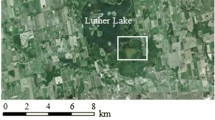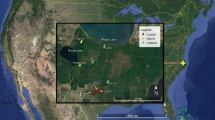Abstract
There are fears that global warming will lead to degradation of peatlands, higher emissions of greenhouse gases from peat, and accelerated warming. Anaerobic decomposition of organic soils produces methane (CH4), a potent greenhouse gas. Two peat bogs differing in mean annual temperature, Velke Darko (VD, Czech Republic, 7.2 °C), and Stor Åmyran (SA, Sweden, 4.0 °C), were selected for a comparative study of how organic soils in different climatic zones will respond to warmer and drier conditions. Twenty peat cores from each bog were incubated in growth chambers. Under present-day summer conditions, VD produced 14 times more CH4 than SA. Two different warming scenarios were used. Peat-core replicates were kept at temperatures of 11 versus 16 °C, and 11 versus 22 °C. From 11 to 16 °C, the CH4 production slightly decreased at SA, and slightly increased at VD. From 11 to 22 °C, the CH4 production increased 9 times at SA, but slightly decreased at VD. After an 8-month incubation, peat cores under drying conditions (water table at −14 cm) were compared to samples with original water table (−2 cm). Drying conditions led to a steeper reduction in CH4 production at VD, compared to SA. The CH4 production decreased more than 100 times at VD. Then, the combined effect of simultaneous warming and drying at 11 and 22 °C was studied. We did not find any significant effect of interactions between increasing temperature and decreasing water table level. Overall, the warmer site VD responded more strongly to the simulated climate change than the colder site SA.




Similar content being viewed by others
References
Alstad KP, Whiticar MJ (2011) Carbon and hydrogen isotope ratio characterization of methane dynamics for Fluxnet Peatland Ecosystems. Org Geochem 42:548–558
Bergman I, Klarqvist M, Nilsson M (2000) Seasonal variation in rates of methane production from peat of various botanical origins: effects of temperature and substrate quality. FEMS Microbiol Ecol 33:181–189
Blodau C (2002) Carbon cycling in peatlands—a review of processes and controls. Environ Rev 10:111–134
Bohdalkova L, Curik J, Kubena AA et al (2013) Dynamics of methane fluxes from two peat bogs in the Ore Mountains. Plant Soil Environ 59:14–21
Bridgham SD, Ping C-L, Richardson JL et al (2001) Soils of northern peatlands: histosols and gelisols. In: Richardson JL, Vepraskas ML (eds) CRC Press
Bubier JL, Moore TR, Juggins S (1995) Predicting methane emission from bryophyte distribution in northern Canadian peatlands. Ecology 76:677–693
Crawley MJ (2002) Statistical computing: an introduction to data analysis using S-plus. Wiley, Chichester
Dise NB (1993) Methane emission from Minnesota peatlands–spatial and seasonal variability. Global Biogeochem Cycles 7:123–142
Dohnal Z, Kunst M, Mejstrik M et al (1965) Bogs and Fens in Czechoslovakia (in Czech). CSAV, Prague
Duddleston KN, Kinney MA, Kiene RP et al (2002) Anaerobic microbial biogeochemistry in a northern bog: acetate as a dominant metabolic end product. Global Biogeochem Cycles 16:1063
Dunfield P, Knowles R, Dumont R et al (1993) Methane production and consumption in temperate and subarctic peat soils: response to temperature and pH. Soil Biol Biochem 25:321–326
Frolkin S, Roulet N, Fuglestvedt S (2006) How northern peatlands influence the Earth’s radiative budget: sustained methane emission versus sustained carbon sequestration. J Geophys Res 111:G01008
Gorham E (1991) Northern peatlands: role in the carbon cycle and probable responses to climatic warming. Ecol Appl 1:182–195
Gunnarsson U, Granberg G, Nilsson M (2004) Growth, production and interspecific competition in Sphagnum: effects of temperature, nitrogen and sulphur treatments on a boreal mire. New Phytol 163:349–359
IPCC (2007) Climate change 2007: impacts, adaptation and vulnerability; Working Group II Contribution to the Intergovernmental Panel on Climate Change Fourth Assessment Report. Brussels
IPCC (2012) Summary for policymakers. In: Field CB, Barros V, Stocker TF et al (eds) Managing the risks of extreme events and disasters to advance. Climate change adaptation. A Special Report of Working Groups I and II of the Intergovernmental Panel on Climate Change. Cambridge University Press, Cambridge and New York
Johnson LC, Damman AWH (1991) Species-controlled Sphagnum decay on a South Swedish raised bog. Oikos 61:234–242
Kettunen A, Kaitala V, Lehtinen A et al (1999) Methane production and oxidation potentials in relation to water table fluctuations in two boreal mires. Soil Biol Biochem 31:1741–1749
Lai DYF (2009) Methane dynamics in northern peatlands: a review. Pedosphere 19:409–421
Laiho R (2006) Decomposition in peatlands: reconciling seemingly contrasting results on the impacts of lowered water levels. Soil Biol Biochem 38:2011–2024
Moore TR, Roulet NT, Waddington JM (1998) Uncertainty in predicting the effect of climatic change on the carbon cycling of Canadian peatlands. Clim Chang 40:229–245
Novak M, Zemanova L, Buzek F et al (2010) The effect of a reciprocal peat transplant between two contrasting Central European sites on C cycling and C isotope ratios. Biogeosciences 7:921–932
Roulet N, Moore T, Bubier J et al (1992) Northern fens: methane flux and climatic change. Tellus 44:100–105
Segers R (1998) Methane production and methane consumption: a review of processes underlying wetland methane fluxes. Biogeochemistry 41:23–51
Strack M, Waddington JM, Tuittila ES (2004) Effect of water table drawdown on northern peatland methane dynamics: implications for climate change. Global Biogeochem Cycles 18:GB4003
Urbanova Z, Picek T, Barta J (2011) Effect of peat re-wetting on carbon and nutrient fluxes, greenhouse gas production and diversity of methanogenic archaeal community. Ecol Eng 37:1017–1026
Venkiteswaran JJ, Schiff SL (2005) Methane oxidation: isotopic enrichment factors in freshwater boreal reservoirs. Appl Geochem 20:683–690
Vile MA, Bridgham SD, Wieder RK et al (2003) Atmospheric sulfur deposition alters pathways of gaseous carbon production in peatlands. Global Biogeochem Cycles 17:1058–1064
Waddington JM, Roulet NT (2000) Carbon balance of a boreal patterned peatland. Global Change Biol 6:87–97
Wagner D, Pfeiffer EM (1997) Two temperature optima of methane production in a typical soil of the Elbe River marshland. FEMS Microbiol Ecol 22:145–153
Whalen SC, Reeburgh WS (2000) Methane oxidation, production, and emission at contrasting sites in a boreal bog. Geomicrobiol J 17:237–251
Wieder RK, Vitt DH (2006) Boreal peatland ecosystems. Ecological studies, 188. Springer, Berlin
Acknowledgments
This work was supported by the Czech Science Foundation (P504/12/1782), and the CzechGlobe–Centre for Global Climate Change Impacts Studies (CZ.1.05/1.1.00/02.0073).
Author information
Authors and Affiliations
Corresponding author
Rights and permissions
About this article
Cite this article
Bohdalkova, L., Novak, M., Buzek, F. et al. The response of a mid- and high latitude peat bog to predicted climate change: methane production in a 12-month peat incubation. Mitig Adapt Strateg Glob Change 19, 997–1010 (2014). https://doi.org/10.1007/s11027-013-9456-0
Received:
Accepted:
Published:
Issue Date:
DOI: https://doi.org/10.1007/s11027-013-9456-0




